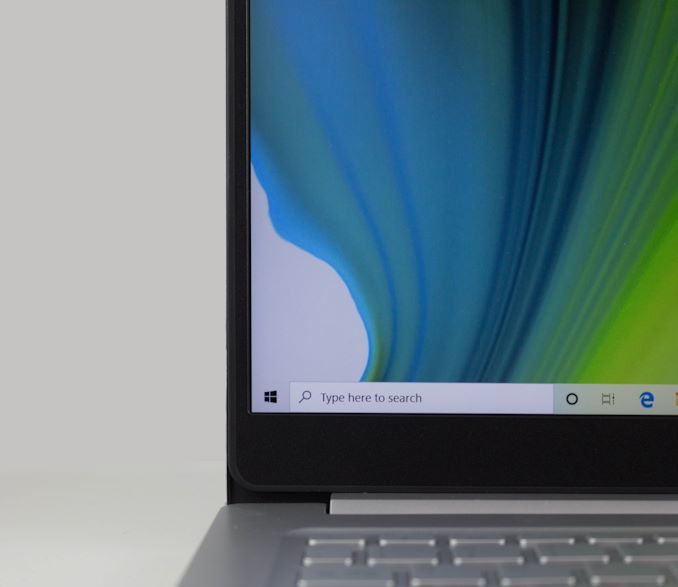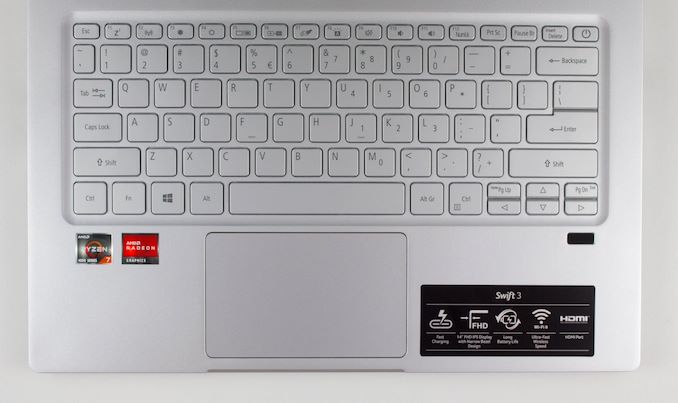The Acer Swift 3 SF314 Notebook Review: Swift Gets Swifter With Ryzen 4000
by Brett Howse & Andrei Frumusanu on May 5, 2020 8:00 AM ESTDesign
Acer’s design ethos for the new Swift 3 would make you think this is a much more expensive device. The 14-inch notebook features an all-aluminum design, offering a much more premium feel than what you’d normally expect on a notebook in this price range. At just 1.2 kg / 2.65 lbs, the 14-inch notebook is extremely portable, and with an 83% screen to body ratio, it is easily as compact as a 13.3-inch notebook from a couple of years ago. Acer’s choice of a 16:9 display does mean that the display has a hefty chin, but is almost certainly a choice that was made to keep the device in-budget.
Despite the thin design and the low price, the aluminum chassis is very stout, with little to no flex no matter how you pick it up. Acer has cut in a slot at the front to make opening the laptop easier, although it will not open with a single finger since the hinge is too stiff to allow this. There is no touch support either, so the hinge stiffness does not need to be quite so tight, but it does make for a solid platform once you open it up.
The keyboard provides a great typing experience. The keys themselves have single-level white backlighting, which works well. The white backlighting on silver keys can cause some contrast issues in bright light, but the effect is not as pronounced as it is on some other devices. Typing offers a surprisingly good keyboard feel, with solid keys that have a solid level of pressure and feedback. Acer has the power button as part of the keyboard, which does make it prone to accidentally turning the device off if you miss the delete key, and moving the power button out of the normal keys would be appreciated, but Acer is far from the only manufacturer to do this, and the laptop resumes instantly so even if it did happen it’s not as big of an issue as it was a few years ago, thanks to the new modern standby options built into Windows and the new CPU.
If there was one area where the notebook showcased it was a lower-cost device, it would be the trackpad. Although it offers the Precision touchpad drivers, the material is not as smooth and responsive as some higher-priced notebooks. This is not so much a knock against the device, but a reality of where it is situated in the market. It does offer the expected multi-touch capabilities you’d expect, it just doesn’t quite offer the level of refinement you’d see in more premium notebooks.
Acer has also included a fingerprint reader, which has great response. It unlocks the device in well under a second even if the display is off. It is a nice to see Windows Hello support despite the lower cost of this device, and the chosen reader seems to work very well. There is no IR camera included, and the built-in webcam is only a 1280x720 unit, so do not expect to be the belle of the Teams meeting, but it gets the job done with a properly located webcam in the top bezel.
Acer offers reasonable I/O as well, with a USB Type-C port on the left, which does support power delivery up to 15 Watts output, and support for charging the device via USB-C as well. There is no Thunderbolt 3, but it does offer DisplayPort output. This is in addition to the included HDMI port, and the laptop also has a USB 3.2 Gen 1 port on the left which supports power-off charging, and a USB 2.0 port on the right, along with a headset jack.
Overall, the Acer Swift 3 is a great design, with a modern feel, and premium materials. The 14-inch notebook is compact, thin, and light, and Acer has done a great job with the look and feel of this device. There are enough ports, and the included USB-C port adds the expanded ability to charge as well as I/O. Looking at this device, you could easily mistake it for a notebook that costs hundreds more.














191 Comments
View All Comments
Oxford Guy - Thursday, May 7, 2020 - link
8 watts is not awesome:"The laptop really struggled with its thermals, dropping the framerate into single digits often. The device attempted to run at around 18 Watts of power draw, slightly over the 15 Watt TDP, but in fact only averaged around 8 Watts during this run."
Not being able to cover the pathetic old sRGB color space with even a slight level of accuracy is not awesome.
sonny73n - Thursday, May 7, 2020 - link
It’s the heat issue on heavy load. Looking at HSF with the back cover opened on TH, I was thinking how to modify it for a better heat dissipation. There’s only one heatpipe running about 3 inches to the fins. I doubt repaste will help much.uzzi38 - Tuesday, May 5, 2020 - link
Because battery life is also about the rest of the components in the laptop as well. The screen especially so. Those results are normalised battery size, not normallised with rest-of-system power draw in mind.Jorgp2 - Tuesday, May 5, 2020 - link
Isn't that still up to AMD?Intel helped spec out low power displays to use with Athena devices
They also make their own chipsets.
SolarBear28 - Tuesday, May 5, 2020 - link
I don't think AMD has the bargaining power (or marketing clout) to force OEM's to use expensive, lower power components the same way Intel does. But they have done something similar by requiring certain specs with their HS series processors.Spunjji - Wednesday, May 6, 2020 - link
Not, it's up to the OEM.OEM's don't even *have* to use Athena, though it looks like they're being heavily "persuaded".
yeeeeman - Tuesday, May 5, 2020 - link
D'oh, obviously. That is where the 650$ price is. In cheap components.SolarBear28 - Tuesday, May 5, 2020 - link
Exactly. The XPS 13 2 in 1 is one of the most efficient Intel devices out there due to its screen and other components. The Swift 3 beats the Yoga C930 in the normalized test, so AMD is roughly in the same ballpark as Intel on power consumption. But its up to the OEM's to do the rest. With their HS series processors AMD pushed certain requirements on ASUS and the ROG G14 provides great battery life. Also the leaked specs of some Renoir Thinkpads point to a proper lower power display being an option, I'm looking forward to seeing reviews of the T14s.Spunjji - Wednesday, May 6, 2020 - link
This. It's not entirely a fair fight.neogodless - Tuesday, May 5, 2020 - link
If I understand correctly, we're talking about battery life from an 8-core processor being only 25% off that of a 4-core processor. That's actually pretty good.